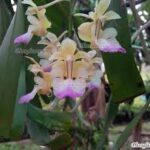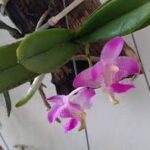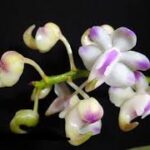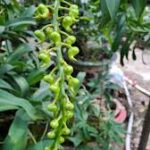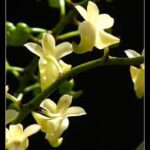
Sato Cymbidium orchids, known for their elegance and beauty, have captured the hearts of orchid enthusiasts and casual admirers alike. With a wide range of varieties, each with its unique characteristics, learning to identify these stunning flowers can enhance your appreciation and understanding of them. In this comprehensive guide, we will explore the distinct features of various Sato Cymbidium orchid varieties, providing you with the knowledge to identify and appreciate their unique attributes.
## 1. Overview of Sato Cymbidium Orchids
Sato Cymbidium orchids, or Cymbidium goeringii, are native to Southeast Asia, particularly Vietnam and China. They are celebrated for their beautiful flowers, which come in various shapes, sizes, and colors. These orchids thrive in temperate climates and are popular among gardeners and floral designers for their stunning blooms and ability to adapt to different environments.
### 1.1 Importance of Identification
Identifying the various Sato Cymbidium orchid varieties is essential for several reasons:
– **Cultivation**: Understanding the specific needs and preferences of each variety can help you provide the best care, ensuring healthy growth and vibrant blooms.
– **Appreciation**: Recognizing the unique features of different varieties enhances your enjoyment of these beautiful orchids, allowing you to appreciate their diversity.
– **Conservation**: Knowledge of various Sato Cymbidium varieties can contribute to conservation efforts, as it helps maintain genetic diversity and promote responsible cultivation practices.
## 2. Key Characteristics for Identification
When identifying different Sato Cymbidium varieties, pay attention to the following key characteristics:
### 2.1 Flower Color
Sato Cymbidium orchids come in various colors, ranging from vibrant reds and pinks to soft whites and greens. The color of the flower is often one of the most distinctive features for identification.
– **Common Colors**:
– **Red and Pink Varieties**: Often associated with joy and happiness, these vibrant colors are popular for celebrations and special occasions.
– **White Varieties**: Symbolizing purity and elegance, white Sato Cymbidium orchids are often used in weddings and formal events.
– **Yellow and Orange Varieties**: These cheerful colors represent warmth and positivity, making them a popular choice for home decoration.
### 2.2 Flower Shape and Size
The shape and size of the flowers can vary significantly between Sato Cymbidium varieties. Observing these features can aid in identification.
– **Common Shapes**:
– **Round Flowers**: Some varieties, such as the ‘Golden Showers’ cultivar, have rounder, more compact blooms.
– **Star-Shaped Flowers**: Varieties like ‘Cymbidium Golden Elf’ display star-shaped flowers with pointed petals, making them easily recognizable.
– **Long-Lasting Blooms**: Certain varieties produce larger flowers that can last longer, such as ‘Misty Dawn,’ which boasts broad petals that open wide.
### 2.3 Leaf Structure and Growth Habit
The foliage of Sato Cymbidium orchids can provide valuable clues for identification. Different varieties exhibit distinct leaf structures and growth habits.
– **Leaf Characteristics**:
– **Leaf Width**: Some varieties, like ‘Green Charm,’ have broader leaves, while others, such as ‘Tropical Breeze,’ feature narrower leaves.
– **Leaf Length**: The length of the leaves can vary, with certain types like ‘Miniature Wonder’ showcasing shorter leaves.
– **Growth Habit**:
– **Compact Growth**: Some varieties have a more compact growth habit, making them ideal for small spaces.
– **Tall Growth**: Others may grow taller, producing long spikes of flowers that can reach impressive heights.
### 2.4 Fragrance
Fragrance is another essential aspect of identifying Sato Cymbidium varieties. While not all orchids are fragrant, many Sato Cymbidium orchids emit delightful scents that can help distinguish them.
– **Fragrant Varieties**:
– Varieties such as ‘Fragrant Rose’ are known for their sweet, floral aroma, making them a favorite among orchid enthusiasts.
– On the other hand, some varieties may have little to no scent, which can also be a distinguishing factor.
## 3. Popular Varieties of Sato Cymbidium Orchids
Now that we’ve covered the key characteristics to look for when identifying Sato Cymbidium orchids, let’s delve into some of the most popular varieties and their unique features.
### 3.1 Cymbidium goeringii
– **Description**: Known as the original Sato Cymbidium, this variety is characterized by its vibrant green flowers and tall spikes. The petals often have a delicate texture, making them visually appealing.
– **Identifying Features**: Green blooms with a hint of yellow, elongated petals, and a tall growth habit.
### 3.2 Cymbidium ‘Golden Elf’
– **Description**: This hybrid variety is beloved for its star-shaped flowers that bloom in bright yellow and orange shades.
– **Identifying Features**: Star-shaped flowers, bold colors, and a compact growth habit, making it perfect for smaller spaces.
### 3.3 Cymbidium ‘Misty Dawn’
– **Description**: A popular choice for its large, beautiful blooms, ‘Misty Dawn’ features soft pink flowers with a creamy center.
– **Identifying Features**: Large, wide-open blooms with a delicate color gradient and robust foliage.
### 3.4 Cymbidium ‘Fragrant Rose’
– **Description**: As the name suggests, this variety is known for its delightful fragrance and stunning rose-pink flowers.
– **Identifying Features**: Fragrant blooms, rich rose color, and a slightly wavy petal structure.
### 3.5 Cymbidium ‘Miniature Wonder’
– **Description**: This compact variety is perfect for indoor gardening, producing smaller flowers that pack a colorful punch.
– **Identifying Features**: Smaller stature, brightly colored blooms, and short leaves.
## 4. Growing Conditions and Care
To successfully cultivate Sato Cymbidium orchids, it’s essential to understand their specific growing conditions and care requirements. While each variety may have unique preferences, many general guidelines apply.
### 4.1 Light Requirements
Sato Cymbidium orchids thrive in bright, indirect light. Too much direct sunlight can scorch their leaves, while insufficient light can hinder blooming.
– **Ideal Lighting**: Place your orchids in a location where they receive filtered sunlight, such as near a window with sheer curtains.
### 4.2 Temperature and Humidity
Sato Cymbidium orchids prefer moderate temperatures and humidity levels.
– **Temperature**: Ideal daytime temperatures range from 70°F to 80°F (21°C to 27°C), while nighttime temperatures should be between 55°F and 65°F (13°C to 18°C).
– **Humidity**: Maintaining humidity levels around 40-60% is crucial for optimal growth. Consider using a humidity tray or a humidifier if your home is dry.
### 4.3 Watering and Fertilization
Proper watering and fertilization practices are essential for healthy growth.
– **Watering**: Water your orchids when the top inch of the potting medium feels dry. Ensure proper drainage to avoid overwatering, which can lead to root rot.
– **Fertilization**: Use a balanced orchid fertilizer every 2-4 weeks during the growing season to promote healthy blooms.
### 4.4 Potting and Repotting
Choosing the right potting medium and repotting when necessary is vital for the health of your Sato Cymbidium orchids.
– **Potting Medium**: Use a well-draining orchid mix that includes bark, perlite, and sphagnum moss to provide adequate aeration and moisture retention.
– **Repotting**: Repot your orchids every 1-2 years to refresh the potting medium and encourage new growth.
## 5. Conclusion
Identifying different varieties of Sato Cymbidium orchids can enhance your appreciation for these beautiful flowers and improve your gardening experience. By understanding the key characteristics—such as flower color, shape, size, leaf structure, and fragrance—you can recognize and care for these stunning orchids more effectively. Whether you are a seasoned orchid enthusiast or a beginner, this knowledge will deepen your connection to the enchanting world of Sato Cymbidium orchids.
As you cultivate and nurture these orchids, you’ll find joy in watching them flourish and bloom, creating a stunning display of nature’s beauty in your home or garden. So take the time to explore the diverse varieties of Sato Cymbidium orchids and celebrate the unique qualities that each one brings to the table.
# How to Identify Different Varieties of Sato Cymbidium Orchids (Part 2)
In the first part of this guide, we explored the fundamental aspects of Sato Cymbidium orchids, including their overall characteristics, key identifying features, and some popular varieties. In this second part, we will delve deeper into more specific identification methods, the significance of genetic traits, and how to utilize these insights for better care and cultivation. This comprehensive approach will further enhance your ability to identify various Sato Cymbidium orchids and appreciate their unique beauty.
## 6. Advanced Identification Techniques
While basic identification methods focus on general characteristics such as flower color, shape, and size, advanced techniques can provide more in-depth insights into the differences between Sato Cymbidium varieties. These techniques include genetic markers, phenotypic variations, and environmental influences.
### 6.1 Genetic Markers
Genetic testing can offer precise information about the lineage and characteristics of Sato Cymbidium orchids. By analyzing specific genetic markers, horticulturists can identify unique traits that may not be immediately visible to the naked eye.
– **DNA Analysis**: Molecular techniques, such as DNA sequencing, allow researchers to pinpoint genetic variations among different Sato Cymbidium varieties. This information can help in classification, breeding programs, and conservation efforts.
– **Hybrid Identification**: Understanding the genetic makeup of hybrid orchids can aid in identifying parent species and understanding the potential characteristics of future generations.
### 6.2 Phenotypic Variations
Phenotypic variations refer to the observable traits of an organism, which can be influenced by both genetic factors and environmental conditions. Sato Cymbidium orchids may exhibit different traits based on their growing conditions, making careful observation essential for accurate identification.
– **Environmental Factors**: Light, temperature, and humidity can affect flower size, color intensity, and growth habit. For example, orchids grown in lower light conditions may produce smaller flowers compared to those grown in bright light.
– **Care Practices**: The way you care for your orchids—such as watering, fertilization, and potting—can also influence their appearance. Understanding these variations can help you identify specific traits that are characteristic of certain varieties.
### 6.3 Utilizing Technology for Identification
In the age of technology, various tools and applications can assist in identifying and documenting Sato Cymbidium orchids.
– **Mobile Apps**: Several mobile applications allow you to take photos of your orchids and receive instant identification based on image recognition technology. These apps can also provide information about care and cultivation.
– **Online Forums and Communities**: Engaging with online orchid communities can provide access to expert knowledge and experiences from fellow enthusiasts. Sharing photos and asking for identification help can yield valuable insights.
## 7. Care and Cultivation Based on Identification
Once you’ve successfully identified a variety of Sato Cymbidium orchid, it’s essential to tailor your care regimen to meet its specific needs. Different varieties may have unique requirements for light, water, temperature, and nutrients.
### 7.1 Light Requirements
As mentioned previously, light is a critical factor in orchid growth. Each variety may have different light preferences.
– **Bright, Indirect Light**: Most Sato Cymbidium orchids thrive in bright, indirect light. However, some varieties may tolerate lower light conditions, making them suitable for indoor environments.
– **Varietal Considerations**: For example, the ‘Golden Elf’ variety prefers brighter conditions to showcase its vibrant colors, while other varieties like ‘Fragrant Rose’ can adapt to moderate light levels.
### 7.2 Watering Needs
Watering practices can vary based on the growth habits and flower characteristics of different varieties.
– **Watering Frequency**: Orchids in bright light may require more frequent watering, while those in lower light may need less. Monitor the potting medium’s moisture level and adjust your watering schedule accordingly.
– **Water Quality**: Using distilled or rainwater can help prevent mineral buildup, which can be harmful to some varieties. Ensure that the water pH is within the optimal range for orchids (5.5 to 6.5).
### 7.3 Temperature Preferences
Temperature preferences can also differ among Sato Cymbidium varieties.
– **Ideal Temperature Range**: Most Sato Cymbidium orchids thrive in moderate temperatures, typically ranging from 65°F to 80°F (18°C to 27°C) during the day and cooler at night. However, specific varieties may have different temperature tolerances.
– **Seasonal Adjustments**: Some orchids, like the ‘Misty Dawn’ variety, may benefit from slightly cooler temperatures during the winter months to encourage blooming.
### 7.4 Fertilization Techniques
Fertilization requirements can also vary based on the growth stage and specific needs of each Sato Cymbidium variety.
– **Balanced Fertilizers**: A balanced fertilizer with equal parts nitrogen, phosphorus, and potassium (NPK) can be beneficial during the growing season.
– **Specialized Formulas**: Some varieties may benefit from specialized orchid fertilizers formulated for specific growth stages, such as bloom-boosting formulas for flowering orchids.
## 8. Notable Rare Varieties of Sato Cymbidium Orchids
While many Sato Cymbidium varieties are popular among enthusiasts, some rare and unique cultivars stand out for their extraordinary beauty and distinct characteristics. Understanding these rare varieties can enhance your knowledge and appreciation of Sato Cymbidium orchids.
### 8.1 Cymbidium ‘Firecracker’
– **Description**: This rare variety is known for its striking red and orange flowers that resemble a firework display.
– **Identifying Features**: Brightly colored flowers with a unique petal shape that opens wide, providing a stunning visual impact.
### 8.2 Cymbidium ‘Blue Moon’
– **Description**: An exceptionally rare variety, ‘Blue Moon’ features pale blue flowers with a subtle fragrance.
– **Identifying Features**: Soft blue petals with delicate white markings, making it a prized addition to any orchid collection.
### 8.3 Cymbidium ‘Rainbow’
– **Description**: Known for its multi-colored blooms, ‘Rainbow’ is a hybrid variety that displays an array of vibrant colors.
– **Identifying Features**: Each flower showcases a unique color pattern, making it a favorite among collectors.
## 9. Understanding Orchid Hybridization
Hybridization plays a significant role in creating new and exciting Sato Cymbidium varieties. Understanding this process can provide insights into the characteristics of various hybrids.
### 9.1 Basics of Hybridization
– **Hybridization Process**: Hybridization involves cross-pollinating two different parent plants to produce a new variety. This process can result in unique traits and characteristics not found in either parent.
– **Goal of Hybridization**: Breeders often aim to enhance specific traits, such as flower color, size, fragrance, and disease resistance.
### 9.2 Common Hybrid Varieties
Several popular hybrid Sato Cymbidium varieties have emerged from the hybridization process.
– **Cymbidium ‘Sherry’**: This hybrid variety boasts large, brightly colored flowers and a robust growth habit, making it a favorite among growers.
– **Cymbidium ‘Summer Delight’**: Known for its striking coloration and pleasing fragrance, this hybrid is a popular choice for floral arrangements.
## 10. Conclusion
Identifying different varieties of Sato Cymbidium orchids requires attention to detail and a deep understanding of their unique characteristics. By utilizing advanced identification techniques, caring for your orchids according to their specific needs, and recognizing rare and hybrid varieties, you can enhance your orchid-growing experience.
The knowledge you gain from this guide will empower you to appreciate the stunning beauty of Sato Cymbidium orchids fully. As you continue your journey into the world of orchids, remember to share your findings with fellow enthusiasts and contribute to the conservation and appreciation of these remarkable plants. Happy growing, and may your Sato Cymbidium orchids thrive in their splendid diversity!

